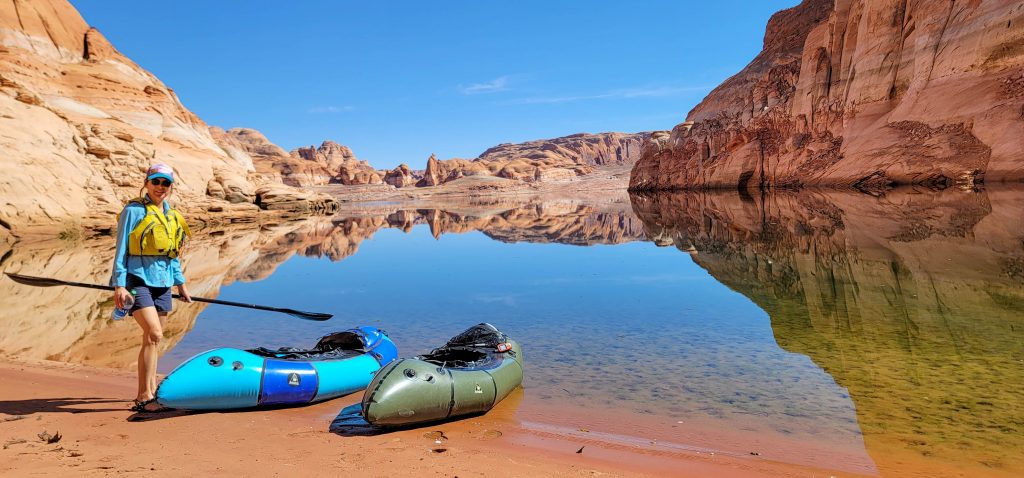Legend has it that upon descending to the Colorado River through the Hole in the Rock, the Mormon Pioneers were greeted by a native who rightfully confused asked where they had come from. They replied that they had descended from the cliffs above through the hole. He did not believe them, called them liars and rode off. I can understand his confusion and disbelief. If it wasn’t for the evidence that exists scratched into the sandstone I would say it was just a myth. A story conjured up like so many others to strengthen the faith of the saints, but as it does stand, there was obviously a “road” built, people did go through and while it is incredibly hard to believe or even comprehend why, it was done.
I’m fascinated by this.

The Era of the Known
Our times are often referred to as the Technology Age. I cannot disagree with that designation, but I would reword it to the Era of the Known. The combined knowledge of humanity for the past however many centuries has culminated in our times giving us the strangely unhuman ability to live a life of perceived certainty.
Consider the steps we now take to go on a journey or what would be better described as a road trip. First, you pick your destination. Second, you jump on the interwebs, input your destination and starting point and boom, you have a route. There is very little unknown on this route. The roads already exist, the machines determined your route and all you have to do is get in your car and follow the instructions being blurted at you through your stereo. You can even have it determine your stops, where to eat, get fuel, places to sleep, etc. Whatever you need, it is known that it is available and where. There is precious little guesswork.
It’s actually incredibly difficult to find an unknown place. Through a dart at a map and it’s almost guaranteed that someone else has been there, written a book about it and posted a youtube video. If you get lucky and they haven’t, it’s not difficult to jump on a computer, find a map, see satellite imagery and know most of what you would experience being dropped into that place. And most places, you can, in fact, be dropped into if you have the money and time to sort it out.
If you start down this rabbit hole and begin to put effort into finding unknown places, it’s unbelievably rare. There are precious few summits untouched, almost no canyons and short of the ocean, this planet has been explored, recorded, mapped and thrust into the database of the known, most likely for the better part of a century. Having spent a good portion of my existence attempting this, I can think of no place I have been that someone else hadn’t already stomped on. There are plenty of places due to their difficult access where it was obvious that there hadn’t been many humans, or only a handful, but the signs are all there.
Looking at this through a lens of loss and gain, it is not a stretch to say that the unknown has been stolen from us.

Through the Portal
I bring my boat in parallel to the small opening. There is a small waterfall cascading into a small pothole that is almost perfectly level with the reservoir. I can see through the clear water below me. The rock I am up against is a cliff that drops vertically into the water as far down as I can see. Falling in wouldn’t be disastrous, but it also isn’t desired. I grasp at the rock trying to find something to hold myself in place. There is a fairly good chance of the classic “step off the boat as it floats away and fall directly in” move happening.
I get one foot out and then the other and make the move onto solid land. The water is pouring in and now I have to go up the waterfall. I toss my paddle up and grab the boat hoisting it over my shoulder I scramble the few feet up to the sandy ledge above. Once secured through the portal, I jump back down to help KB repeat the action. I’m forced back up as the pothole isn’t big enough for both of us and then, using my paddle, I help steady her boat so she can make the transition.
And just like that we are in Cottonwood Canyon.
Most people visiting the Hole, focus mostly on it and for good reason. You can drive to the top, see the plaque, say you’ve been there and then drive home over the 50+ miles of bumpy road. Most folks who get there have had enough adventure just by arriving. A few brave souls will even venture down to the reservoir experiencing the drop that the pioneers did in wagons by scrambling through the rock piles and talus that is left over from the road. At the bottom, the reservoir becomes a sizable obstacle to overcome turning visitors back around and up to their car at the top.
Getting to Cottonwood Canyon is much more difficult. You have two options, come by boat or by jeep. The boat route gets you access but will keep you tethered to that end of the road. Jeeping follows the original route blazed by the Hole in the Rockers, but takes a couple of days and you’ll need a very capable, high-clearance vehicle. Using our packrafts, we cheat. We use the short span of the lake to access the bottom and then simply roll up our small craft and carry them with us.

Any Hole in the Rock historian will tell you that dropping to the river was a major feat in and of itself. Impressive in size and magnitude and almost unbelievable, but getting from the river up the other side was an even bigger accomplishment. The sandstone canyons, domes and ledges don’t stop at the river. They continue for miles and form a formidable barrier between the Mormons and their proposed destination. For this exact reason, it has intrigued me ever since I learned it existed and has almost become an obsession from the first time we dragged packrafts down the Hole.

Into the Unknown
The Hole in the Rock Gang of Pioneers had little if any beta past the sandstone toward the end of 50 Mile Bench. As they approached the town of Escalante, they began sending out scouts to explore and sort out if a road could even be built through the area. From the rim of the canyon and into the red sandstone, the area was unknown even to the residents of Escalante. A few cattlemen had ventured down to the river, but the area above was easier to access and better for cattle.
As the group approached the rim, they sent out two different expeditions to see what was down there. Both came back with less than favorable descriptions and recommendations. By the time the pioneers had reached the Hole in the Rock, they still had no idea how they were getting down, across and then over the miles of sandstone to the San Juan. As these things go, they had a meeting. After much debate and the negative reports, they determined they were too far in to turn around now and they were going in. Essentially, they were committed
They pushed on, building a road through the hole and over the other side. All the while entering what had been unknown to them just days prior and building a road that the scouts suggested could get through. Sometimes making only miles forward progress over days.

Attempting to follow the pioneer’s route, we began walking. Due to the historically low level of the reservoir, we are starting closer to where they would have than has been possible for half a century. Huge banks of sediment line the canyon. The only thing more impressive than their size is that the tiny stream trickly out of the sandstone has already cut a deep gash and washed out an equally impressive amount of sand.
Seeing that this first section has been underwater for half a century, the route doesn’t exist as we begin walking. The canyon is our road and we follow it picking our way around the sediment and creek and slowly progressing toward the high water mark where we find the remnants of the road. Within just a few short miles, we have ascended enough that we can look back and see the Hole in the Rock. I can’t help but wonder if the pioneers looked back longingly as they slaved away spending weeks building the road. Truth be told, when they were at the top prior to dropping down, they already felt like there was too much forward momentum to turn around. Dropping to the river would have only doubled down on their gamble, betting that they could actually get to the San Juan.
Having satellite imagery at our disposal, I know there is water close to where the road climbs up a big sand dune and leaves the canyon. This is our planned camp as we won’t have readily accessible water until we return to the reservoir for camp 2 the next evening. I’m somewhat hesitant to leave the canyon as it has shown us many gems and my imagination is running wild with what else could be seen farther in, but we climb up the sandy hill and find a flat place to camp for the evening.

Our camp is just below some hand-lain rocks from the original road. I feel privileged to be in this spot as I have been dreaming about it for years. We sit and enjoy some tea whilst watching the sunset. We hobo camp as there are almost no clouds in the sky and the mosquitoes don’t appear to be biting (they were).
We awake to clouds. The air is chilly, but I’m giddy to get moving. We have about 17 miles to walk to get back to the reservoir. We are in unknown territory, at least for us. The road is now visible and we have HITR posts to help guide us just in case.
The road continues up the sand dune and then hits the sandstone. The blast marks are still visible and the sides of the rock have been hewn off to create a bench just wide enough for a wagon or at least I assume it’s wide enough. It looks damn narrow to me. A modern jeep would be hard-pressed to keep all 4 wheels on the ground. The dugways, as these benches are referred to, are broken up by smooth sections of sandstone and equally impressive chutes that were also blasted to make them wide enough for access. Mile after mile of this continues up to Grey Mesa.
Almost the entire climb has views of Hole in the Rock. I wonder if the pioneers longed for that camp, for the known as they pushed through this inhospitable sea of rock.
Our route veers off of this Mesa leaving the Pioneers and drops into the Rincon.

The Need to Know
It is our nature to want to know.
As we are able to know and find out things, our desire does not wane, it grows. We have endless information at our fingertips and yet, we cannot let that be enough. We seek out more information, more beta, more details. The unknown is so little and yet we are all so worried about it. We work ourselves up into a tiffy (yea, I just wrote that and you read it) because that last detail is unknown, the great what if. The worst feeling is not knowing.
There were really only a couple of unknowns and they were more iffy than fully unknown. Water was the big one.
As I mentioned, the Portal was unexpected. The water level of the reservoir had dropped and suddenly a new obstacle had appeared. Had the level dropped even another 5 feet, we would have had a hell of a time getting into the canyon at our planned location. Not a trip ending situation, but certainly a trip extending obstacle. Hitting that small waterfall and seeing the cliff extending deep into the dark of the lake, was a bit of a gut check.
Then we had the issue of water between camps. Sattelite imagery showed water flowing in Cottonwood. We also knew we would end back at the reservoir. This left 17 miles of sand and stone to cross. Not only would we be carrying our boats, but we would need to carry enough water to get us across those miles and to the reservoir at the end.
The closer we got to the Rincon, the more worried I became that the reservoir would actually be inaccessible. The Lickers were ahead of us, so we had a good idea that we could get through, but there was always that what if. This was compounded as we got to the rim and the rain started. Receeding reservoirs leave nasty, sink up to your thighs, you ain’t getting out of this, mud. Add extra moisture to the mix and areas accessible one day could easily be a serious obstacle the next.
And then there was the water we had to paddle.
To get from the Rincon and back to the Hole, we had an all day paddle across flat water through a sandstone canyon that is known for sudden bursts of wind that churns calm waters into white capping waves in minutes.
We woke up to wind.

Comparing my water anxiety to what the San Juan pioneers must have felt is ludicrous, but that is where we are.
16.5 miles of flat water lay between us and our exit back up the Hole in the Rock. The wind is not only a concern, it is our major obstacle of the day. Neither Mama Bear nor myself have any desire to reverse our hike with boats on our backs, so we pack up, blow up and put on.
We are camped at the mouth of the Rincon in a cove. It takes us almost 30 minutes to just get out of the cove to the main channel. The wind is blowing constantly in the wrong direction. The only solace is the fact that we can see the first gooseneck and hope that the wind will continue in that direction once we get there propelling us forward. Having spent a few minutes in canyons, I know this is probably not probable.
We struggle forward. Resting isn’t an option because if we stop paddling, we move backward. Each stroke is a struggle akin to running up an escalator going down. We hit the gooseneck after 2.5 hours of paddling and having only progressed a mere 4.5 miles. To our relief, the wind lessens as we begin the turn and then all but turns off as we head in the opposite direction. Not the best-case scenario, but close enough to be very happy about it.
With the wind gone, we have nothing left to do but paddle and enjoy a reservoir that is disappearing and that we have entirely to ourselves. As my mind wanders, I keep returning to the Hole in the Rockers and the insance amount of energy they put into getting to a place they did not know. A place that they hoped would become home, but they also knew lay deep in the desert in the middle of nowhere far removed from the rest of Deseret. I contemplate what they didn’t know, but also what it was that they thought they knew that kept them moving. A strong argument could be made that survival was their biggest motivation in moving forward. It wasn’t just that they were committed that kept them going, it was that turning around almost seemed worse. Winter had fallen on their tracks and it was a long way back to Potato Valley.

I don’t think I will ever tire of this place or these ideas. The closest I’ve come to finding the unknown is here, tucked away in the desert. Every time I go in, I come back out with new scars and new plans to go to the blank spots I haven’t seen yet. Every twist of the canyon is an unknown until I walk around it and it is in my nature to seek to know what is around every corner. The entirety of the road built is still unkown to me, I’ve traveled a lot of it, but there is still the end, the getting to the place, the foot step that brings the San Juan into view. That is one I hope to take soon.
It will continue to be a myth until it stops being an unknown.
Embrace Chaos. Seek Discomfort.


